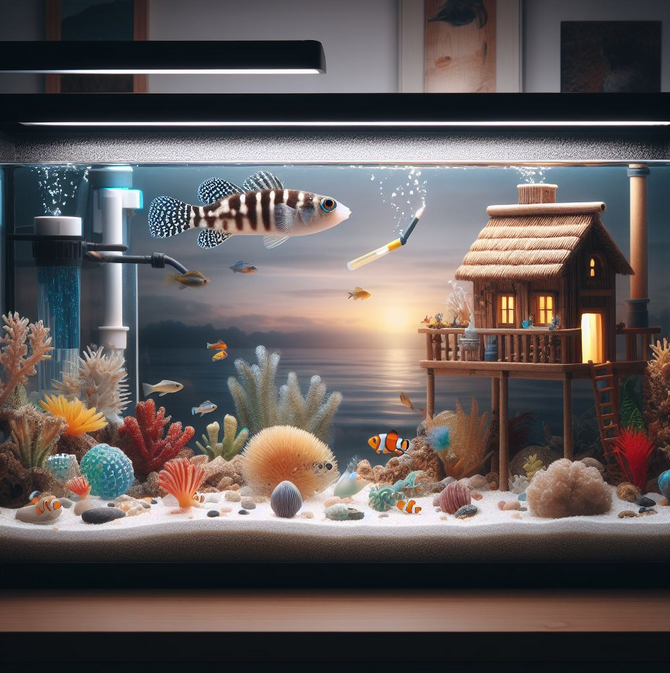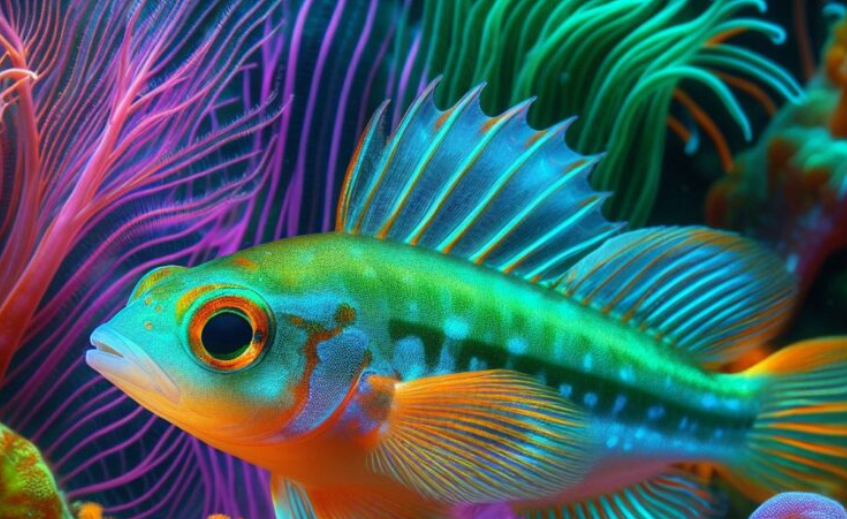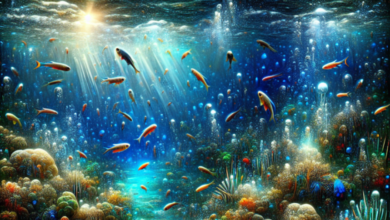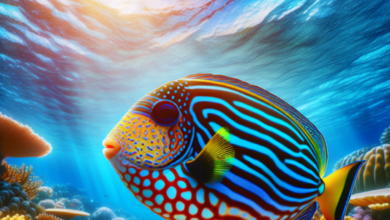Saltwater goby fish are a popular choice for marine aquarium enthusiasts due to their vibrant colors, unique personalities, and relatively low maintenance requirements. In this article, we will provide expert tips on how to care for these fascinating fish and offer valuable information about different species of gobies that you can keep. Whether you are a seasoned aquarist or a beginner, this guide will provide you with all the essential information you need to create the perfect habitat for your saltwater goby fish.
Key Takeaways:
- Saltwater goby fish are vibrant and unique creatures that can make a great addition to a marine aquarium.
- Proper care is essential for the health and well-being of saltwater goby fish.
- Different species of gobies may require different care requirements, so it’s important to research before choosing.
- A balanced diet, suitable tankmates, and optimal tank conditions are crucial for the overall success of a saltwater goby fish tank.
- Breeding saltwater goby fish can be a rewarding experience, but it requires specific techniques and conditions.
Understanding Saltwater Goby Fish
Before delving into the specifics of keeping saltwater goby fish, it’s essential to grasp the basics of these aquatic creatures. Gobies are small, elongated fish known for their vibrant colors and unique personalities, making them a popular choice among marine aquarium enthusiasts. Understanding their natural habitat and behavior is crucial to creating a suitable environment for them to thrive.
The Natural Habitat of Gobies
Gobies are found in saltwater habitats worldwide, including shallow reefs, seagrass beds, and sandy bottoms. They prefer warm waters with a temperature range between 70°F to 80°F and a salinity level of 1.020 to 1.025. Gobies are often found hiding in crevices, burrowing in the sand or rocks, and perching on coral branches or other structure. The ideal tank setup should mimic their natural habitat to keep them healthy and happy.
Goby Behavior
Gobies are known for their unique behaviors, which makes them fascinating to observe. Some gobies are burrowers, others are grazers, while some are cleaners that pick parasites and dead skin from larger fish. They are social fish and often form symbiotic relationships with other marine creatures, such as shrimps, crabs, and sea urchins. Gobies are not aggressive and coexist peacefully with most species, making them ideal for community tanks.
Unique Characteristics of Gobies
Gobies have several unique characteristics that set them apart from other fish. For example, they have fused pelvic fins that form a suction cup, allowing them to attach themselves to surfaces and hold tight against strong currents. Gobies can also change colors to blend in with their surroundings, making it harder for predators to spot them. Some gobies can produce sound, using their swim bladder, and their eyes can rotate independently, allowing them to keep watch for potential threats in multiple directions.
Understanding these unique characteristics will help you appreciate and care for saltwater goby fish properly. Now that you have a basic understanding of these fascinating fish, let’s move on to the next section and learn how to set up the perfect saltwater goby fish tank.
Setting Up the Perfect Saltwater Goby Fish Tank
Creating a suitable environment for your saltwater goby fish is crucial for their health and well-being. The first step is to determine the appropriate tank size, which will depend on the number of gobies you plan to keep. Generally, a minimum of 20 gallons is recommended for a single goby, with an additional 10 gallons for each additional fish.

The next step is to set up the tank with the necessary equipment, such as a heater, filtration system, and protein skimmer, to maintain stable water parameters and adequate oxygen levels. It’s essential to cycle the tank for several weeks before adding any fish to establish a healthy ecosystem.
Water Parameters
Saltwater goby fish thrive in a specific range of water parameters, including:
- Salinity: 1.020-1.026
- Temperature: 72-82°F
- pH: 8.1-8.4
- Ammonia: 0 ppm
- Nitrite: 0 ppm
- Nitrate:
It’s essential to monitor these levels regularly and perform routine water changes to maintain a healthy and stable environment for your gobies.
Decorations
Gobies prefer a well-decorated tank with ample hiding spots, including live rock, caves, and crevices. These decorations also provide essential bacteria, aiding in the biological filtration process. Ensure any decorations or substrate used in the tank are appropriate for a marine environment, as some materials can leach toxins into the water.
Compatibility
When selecting tankmates, it’s important to consider the compatibility of different species, including their size, behavior, and dietary requirements. Gobies are generally peaceful and can coexist with other non-aggressive fish, such as clownfish and tangs. However, they may become territorial and aggressive towards other gobies of the same species.
Overall, setting up a suitable tank requires careful planning and attention to detail. By following these guidelines, you can create a thriving habitat for your saltwater goby fish.
Feeding Saltwater Goby Fish
A balanced and nutritious diet is essential for the health and well-being of your saltwater goby fish. Gobies are omnivores, which means they consume both animal and plant-based food sources. In their natural habitat, gobies feed on small crustaceans and planktonic organisms.
When setting up a feeding schedule for your gobies, avoid overfeeding them, as it can result in health problems such as bloating, constipation, and water quality issues. Additionally, underfeeding your gobies can lead to malnutrition and stunted growth.
Dietary Requirements
The main dietary requirements for saltwater goby fish include proteins, vitamins, and minerals. Some of the protein-rich food sources that you can feed your gobies include brine shrimps, mysis shrimps, and krill. Gobies also require vegetable matter, which can be supplied through feeding them algae-based foods.
It’s essential to provide your gobies with a varied diet to ensure they receive all of the necessary nutrients. Diversifying their food can also enhance their natural feeding behaviors and keep them active and healthy.
Suitable Food Options
Here are some suitable food options for your saltwater goby fish:
- Brine shrimp
- Mysis shrimp
- Krill
- Algae wafers
- Nori seaweed
- Spirulina flakes
- Frozen food mixes for marine omnivores
Feeding Schedule
Feed your saltwater goby fish once or twice a day in small amounts that they can consume within a few minutes. It’s recommended to feed your gobies at the same time every day to establish a regular feeding schedule.
Try to feed your gobies a variety of food options, alternating between protein and vegetable-based sources. Providing a balanced and diverse diet can stimulate their natural feeding behaviors and keep them healthy and happy.
Tips for Proper Feeding
- Thaw frozen food before feeding it to your gobies
- Observe your gobies while feeding to ensure they consume their food properly
- Remove any uneaten food from the tank after feeding to prevent water quality issues and uneaten food from harming your gobies
- Consider using a feeding station to prevent food from spreading around the tank and make it easier for your gobies to locate their food
By following these tips and providing your saltwater goby fish with a balanced and diverse diet, you can ensure their well-being and longevity in your marine aquarium.
Compatible Tankmates for Saltwater Goby Fish
Choosing the right tankmates for your saltwater goby fish is essential for creating a tranquil and thriving aquarium. Although gobies are generally peaceful, they can become aggressive towards their own kind and other fish that resemble them. Therefore, selecting compatible species is crucial to avoid any potential conflicts and maintain a harmonious community. Here are some compatible tankmates for your saltwater goby fish:
Firefish
Firefish is a popular choice among saltwater aquarium enthusiasts due to its striking colors and active behavior. These fish are a great match for gobies as they occupy different areas in the tank, with firefish swimming near the top and gobies close to the bottom. Additionally, firefish are hardy and adaptable, making them an ideal companion for gobies.
Clownfish
Another popular choice for saltwater aquariums is the clownfish. These fish are easy to care for and come in a variety of vibrant colors. They also have a unique symbiotic relationship with anemones, providing an additional natural element to the tank. Clownfish and gobies get along well, and their contrasting personalities and behaviors can create a visually appealing display.
Blennies
Blennies are another type of fish that can coexist peacefully with saltwater goby fish. They are small, have an interesting appearance, and tend to stay on the lower levels of the aquarium, making them unlikely to compete with gobies for space. Blennies are also active and entertaining to watch, adding to the overall dynamics of the tank.
| Compatible Tankmates | Incompatible Tankmates |
|---|---|
| Firefish | Other gobies |
| Clownfish | Aggressive fish |
| Blennies | Fish that resemble gobies |
Keep in mind that every fish has its unique temperament and behavior, and some species may not get along despite being technically compatible. When introducing new fish to your aquarium, monitor their behavior closely and be prepared to remove any fish that become aggressive or pose a threat to others.
Common Saltwater Goby Fish Species
Saltwater goby fish are known for their vibrant colors and unique characteristics. In this section, we will highlight some of the most common species of gobies found in the marine aquarium hobby, providing insights into their distinctive personalities and care requirements.
| Common Name | Scientific Name | Size | Diet | Behavior |
|---|---|---|---|---|
| Green Mandarin Goby | Synchiropus splendidus | 2.5 inches | Small invertebrates | Peaceful, solitary |
| Firefish Goby | Nemateleotris magnifica | 3.5 inches | Small invertebrates | Peaceful, active |
| Yellow Watchman Goby | Cryptocentrus cinctus | 4 inches | Small crustaceans | Pair bonding, peaceful |
| Bumblebee Goby | Brachygobius xanthozona | 1.5 inches | Small crustaceans | Aggressive, territorial |
Note that these are only a few of the most common saltwater goby fish species. We recommend thoroughly researching each species’ care requirements before introducing them to your aquarium. It is essential to ensure that your new fish will thrive in your specific tank setup.
Whether you prefer a peaceful, solitary fish or a social and active one, there is a saltwater goby species that will fit your preferences. By maintaining proper water quality, feeding a balanced diet, and ensuring the compatibility of your tankmates, you can create an enchanting and harmonious environment for your saltwater goby fish to thrive.
Breeding Saltwater Goby Fish
One of the most exciting aspects of owning saltwater goby fish is the opportunity to breed them in a controlled environment. Breeding gobies can be a challenging yet rewarding experience for any aquarium hobbyist.

Requirements for Breeding Saltwater Goby Fish
The first step to successfully breeding saltwater goby fish is to create a suitable breeding environment within your aquarium. A separate breeding tank is recommended, as it allows you to control the conditions more precisely. The breeding tank should be relatively shallow, with a depth of no more than 15 inches. This allows for plenty of surface area for the gobies to lay their eggs.
You should provide the breeding tank with ample hiding spots, such as live rock or PVC pipes, where the female goby can lay her eggs. The substrate should be fine-grained sand, as it mimics the gobies’ natural environment. The water temperature should be between 78°F to 82°F, and the salinity between 1.020 to 1.024.
Spawning Behavior of Saltwater Goby Fish
The breeding process starts when the male goby begins to court the female. The male will build a nest in one of the hiding spots you provided and will lure the female to the nest. Once the female lays her eggs, the male will fertilize them and guard the nest from any predators.
The female can lay anywhere from 50 to 200 eggs, depending on the species. After about three days, the eggs will hatch into fry. The fry are tiny and require minute food, such as rotifers. In the first few days, the fry should be fed several times a day, and the water temperature should be kept at a stable temperature of around 78°F.
Caring for the Fry
You will need to keep a watchful eye on the fry for the first few weeks, as they are incredibly vulnerable and can easily die if the conditions are not adequately maintained. You should keep them in the shallow breeding tank until they are around one inch long, at which point you can move them to a more prominent display tank.
Please note that not all saltwater goby fish species can be bred in captivity. Some species require unique environmental conditions or are yet to be successfully bred in captivity.
Common Health Issues and How to Prevent Them
When it comes to saltwater goby fish, ensuring their health and well-being should be a top priority. Unfortunately, like any other fish, gobies can be prone to certain health issues. Understanding these common ailments and taking steps to prevent them is crucial to maintaining a vibrant and thriving aquarium.
Common Health Issues
| Health Issue | Symptoms |
|---|---|
| Ich | White spots on the body and fins, loss of appetite, lethargy |
| Fin Rot | Torn, ragged fins, discoloration, and inflammation |
| Parasites | Flashing behavior, excessive mucus on the body, and discolored patches |
| Bacterial Infections | Open sores or ulcers, sluggish movement, and loss of appetite |
It’s important to note that many health issues in saltwater goby fish can be attributed to poor water quality. High levels of ammonia, nitrite, and nitrate can put stress on the fish and compromise their immune system, making them more susceptible to illness.
Prevention
Thankfully, many common health issues in saltwater goby fish can be prevented with proper care and attention. Here are some tips to keep your gobies healthy:
- Keep the water clean and well-maintained, with proper filtration and regular water changes.
- Quarantine new fish for at least two weeks to prevent the spread of disease.
- Feed a balanced diet with high-quality food and avoid overfeeding.
- Observe your fish daily for any signs of illness, and address any issues promptly.
By following these prevention measures and maintaining a healthy living environment, you can keep your saltwater goby fish thriving for years to come.
Conclusion
In conclusion, saltwater goby fish are fascinating creatures that can thrive in a well-maintained marine aquarium. By following the care guide and species info provided in this article, you will be well-equipped to create a suitable and enriching environment for your gobies, allowing you to enjoy their vibrant colors and unique behaviors.
Remember to continually monitor their health and maintain optimal tank conditions to ensure their long-term happiness. Keeping saltwater goby fish can be a rewarding and fulfilling experience, but it’s important to always prioritize the well-being of your fish.
Thank you for reading our saltwater goby fish care guide and species info. We hope you found it informative and helpful in your journey as a saltwater aquarium enthusiast. Happy gobying!
FAQ
What are saltwater goby fish?
Saltwater goby fish are a type of small, colorful fish that are native to marine environments. They are known for their interesting behaviors and vibrant colors, making them popular choices for marine aquarium enthusiasts.
How do I care for saltwater goby fish in a marine aquarium?
To care for saltwater goby fish, it is important to provide them with a suitable tank setup, maintain proper water parameters, provide a balanced diet, and choose compatible tankmates. Regular monitoring of their health and maintaining optimal tank conditions is also essential for their well-being.
What are some common species of saltwater goby fish?
Some common species of saltwater goby fish include the Neon Blue Goby, Firefish Goby, Yellow Clown Goby, and the Watchman Goby. Each species has its own unique characteristics and care requirements that should be considered when keeping them in a marine aquarium.
What tank size is suitable for saltwater goby fish?
Saltwater goby fish can be kept in smaller tanks, but a minimum tank size of 20 gallons is recommended to provide them with ample space to swim and establish territories. However, larger tanks with more swimming space are always better for these active fish.
What should I feed my saltwater goby fish?
Saltwater goby fish are omnivorous and will eat a variety of foods, including small live and frozen foods, as well as high-quality flakes and pellets. It is important to provide them with a balanced diet that includes both protein and plant-based foods to ensure their nutritional needs are met.
Can saltwater goby fish be kept with other fish species?
Yes, saltwater goby fish can coexist peacefully with other compatible fish species in a community aquarium. However, it is important to choose tankmates that have similar care requirements and temperaments to avoid aggression or conflicts. Researching and selecting suitable tankmates is crucial for maintaining a harmonious tank environment.
Are saltwater goby fish prone to any health issues?
Like all fish, saltwater goby fish can be susceptible to certain health issues, including parasitic infections, bacterial diseases, and nutritional deficiencies. Proper tank maintenance, regular monitoring, and a balanced diet can help prevent these health issues. In case of concerns, it is recommended to consult with a veterinarian specializing in fish health.
How can I breed saltwater goby fish in a controlled environment?
Breeding saltwater goby fish can be challenging, but it is possible with the right setup and techniques. Providing them with suitable spawning sites, maintaining proper water parameters, and offering a nutritious diet are key factors in successful breeding. Caring for the fry until they reach maturity also requires special attention and care.
How can I prevent common health issues in saltwater goby fish?
To prevent common health issues in saltwater goby fish, it is important to maintain optimal water quality, provide a balanced diet, quarantine new additions to the tank, and perform regular health checks. Early detection and prompt action are crucial in preventing and treating any potential health problems.





One Comment